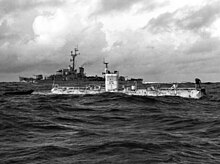Bathyscaphe


A bathyscaphe (
The float is filled with gasoline because it is readily available, buoyant, and, for all practical purposes, incompressible. The incompressibility of the gasoline means the tanks can be very lightly constructed, since the pressure inside and outside the tanks equalises, eliminating any differential. By contrast, the crew cabin must withstand a huge pressure differential and is massively built. Buoyancy at the surface can be trimmed easily by replacing gasoline with water, which is denser.[citation needed]
Auguste Piccard, inventor of the first bathyscaphe, composed the name bathyscaphe using the Ancient Greek words βαθύς (bathús), meaning "deep", and σκάφος (skáphos), meaning "vessel, ship".
Mode of operation
To descend, a bathyscaphe floods air tanks with sea water, but unlike a submarine the water in the flooded tanks cannot be displaced with compressed air to ascend, because the water pressures at the depths for which the craft was designed to operate are too great. For example, the pressure at the bottom of the Challenger Deep is more than seven times that in a standard "H-type" compressed gas cylinder. Instead, ballast in the form of iron shot is released to ascend, the shot being lost to the ocean floor. The iron shot containers are in the form of one or more hoppers which are open at the bottom throughout the dive, the iron shot being held in place by an electromagnet at the neck. This is a fail-safe device as it requires no power to ascend; in fact, in the event of a power failure, shot runs out by gravity and ascent is automatic.

History of development
The first bathyscaphe was dubbed
Piccard's second bathyscaphe was actually a third vessel
Accomplishments
In 1960 Trieste, carrying Piccard's son Jacques Piccard and Don Walsh, reached the deepest known point on the Earth's surface, the Challenger Deep, in the Mariana Trench in the Pacific Ocean.[1]
The onboard systems indicated a depth of 37,800 ft (11,521 m) but this was later corrected to 35,813 ft (10,916 m) by taking into account variations arising from salinity and temperature. Later and more accurate measurements made in 1995 have found the Challenger Deep to be slightly shallower at 35,798 ft (10,911 m).
The crew of the Trieste, which was equipped with a powerful light, noted that the seafloor consisted of diatomaceous ooze and reported observing "some type of flatfish, resembling a sole, about 1 foot long and 6 inches across" (30 by 15 cm) lying on the seabed.[3] This put to rest the question of whether or not there was life at such a depth in the complete absence of light.
See also
- 1948 FNRS-2 – First bathyscaphe
- 1953 FNRS-3 – Bathyscaphe of the French Navy
- 1953 Trieste– Deep sea scientific submersible
- 1961 Archimède – French Navy bathyscaphe
- 1964 Trieste II– US Navy's second bathyscaphe
- 1966 Alvin – Crewed deep-ocean research submersible
- 1964 Aluminaut – First aluminum hulled submarine
- 1970 DSV Shinkai – Crewed research submersible
- 1987 MIR – Self-propelled deep submergence vehicle
- 2012 Deepsea Challenger
- 2018 DSV Limiting Factor
- Sea Pole-class bathyscaphe – Chinese bathyscaphe class
- Timeline of diving technology – Chronological list of notable events in the history of underwater diving equipment
- Submersible – Small watercraft able to navigate under water
- Diving chamber – Hyperbaric pressure vessel for human occupation used in diving operations
- Deep-sea exploration – Investigation of ocean conditions beyond the continental shelf
References
- ^ OCLC 16986801. Archived from the original on 1 August 2008. Retrieved 2008-07-10.)
{{cite journal}}: CS1 maint: unfit URL (link - ^ "Chapter 11" (PDF). Wet Paper. Archived from the original (PDF) on 2008-09-11. Retrieved 2008-09-25.
- ^ "To the bottom of the sea" Archived 2008-12-03 at the Wayback Machine, T. A. Heppenheimer, AmericanHeritage.com
External links
- Barham EG (May 1963). "Siphonophores and the Deep Scattering Layer". Science. 140 (3568): 826–828. S2CID 43485719.
- The US Navy account of the dive, with photographs
- Brewington, Krystal (2003). "Depth of the Deepest Dive in a Bathyscaphe". The Physics Factbook.
- History of the Bathyscape Trieste
- FNRS-2
- "13,000 Feet Under the Sea in the French Bathyscaphe Popular Mechanics, May 1954, pp. 110–111.
- Deepsea Challenger – Mariana Trench Dive (03/25/2012).
